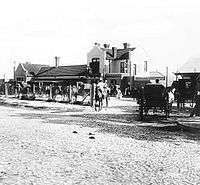Mar del Plata railway station
Mar del Plata | |
|---|---|
| Regional | |
|
Station platforms in 2008. | |
| Location |
Av. Pedro Luro 4400, Mar del Plata Argentina |
| Coordinates | 37°59′17″S 57°33′58″W / 37.9880°S 57.5661°WCoordinates: 37°59′17″S 57°33′58″W / 37.9880°S 57.5661°W |
| Owned by | Government of Argentina |
| Operated by |
BA Southern R (1886-1948) Ferrocarriles Argentinos (1948-1993) Ferrobaires (1993-2011) |
| Line(s) | Roca |
| Distance | 400 km (250 mi) from Buenos Aires |
| History | |
| Opened | 1886 |
| Closed | 2011 |
Mar del Plata (also known as "Mar del Plata Norte") is a former railway station in the homonymous city of Buenos Aires Province, Argentina. Opened in 1886, the station was closed when the new railway and bus terminal was opened in 2011.[1][2]
History



In August 1861, Edward Lumb, a British entrepreneur, requested the concession of a railway line, initially projected to run from Constitución to Chascomús, 120 km from Buenos Aires.[3]
On September 26, 1886, the first train arrived to the city of Mar del Plata, which was the main tourist destination during summer season.[4]
By 1910 Mar del Plata was the main beach city of Argentina, receiving a huge number of tourists during the summer. Due to the intense traffic of passengers, the railway station exceeded its capacity and the Municipality demanded the company to increase the facilities. The company had always denied to this request alleging that the station was only overcrowded during two months per year (the period of summer season in Argentina).
During the first decade of the 20th century, the urban development of Mar del Plata moved from the downtown to the South West (nearest to the coast) so the train station was far from the residences and hotels where the tourist were hosted. In June 1908, the Congress promulgated Law 5.535, authorizing the BAGSR to build a new station in Mar del Plata.
Although the construction of a new station had been approved, a residents' committee (led by Mar del Plata pioneer Pedro Luro) opposed the old station being demolished, requesting its preservation. Percy Clarke, manager of the company had to accept the residents' claim. The other point of conflict with the inhabitants of the city was the path of the new line. While the company wanted to build the new station near to the coast (to reduce costs), the residents demanded that the station should be located far from the most populated areas of the city. Eventually, the BAGSR agreed to build the new station where the neighbours had demanded.
Works began in 1909 and were finished one year later, when the station building began to be constructed. The project of the company also included to extend the tracks to the city of Miramar. The new station in Mar del Plata (named "Mar del Plata Sur") was opened on December 1, 1910, although the main building was not still finished, so a provisional wooden-structure was opened to the public for the 1910–11 summer season.
As Mar del Plata Norte remained active, the Sud station would be only used during the summer seasons. It had two large platforms, the main building, a post warehouse, and a signal cabin. When the new station opened, all the trains that arrived to the old station were reprogrammed to make their arrival to the South station. It totalled four services per day, including the two express services. Nevertheless, a few days before the inauguration, the BAGSR requested to the Government that only the express services arrived to the new station, due to the other three trains programmed having to end their routes in Miramar and could not change their path to the south station. The request was approved and therefore only the express services stopped at the new station.
When the entire Argentine railway network was nationalised in 1948, Mar del Plata became part of General Roca Railway, one of the six divisions of state-owned Ferrocarriles Argentinos.
On May 3, 1949, the Mar del Plata Sud station was definitively closed so Mar del Plata Norte became the only station in the city. In 1951 Ferrocarriles Argentinos acquired a total of 46 coaches from American Budd Company, used for The Marplatense, a luxury service from Buenos Aires to Mar del Plata. In 1952 the FADEL locomotives were added to tow the Marplatense express with a journey time of 3 hours and 45 minutes.
FA ran trains until 1993 when the service was taken over by Ferrobaires, a company owned by the Buenos Aires Province. Ferrobaires has been operating standard services between Mar del Plata and Buenos Aires since then.
In 2009, the bus terminus (that operated in old Mar del Plata Norte station building) moved to a new building, very close to the still active railway station in the centre of the city.[5] It was also announced that the old building would be preserved as a cultural centre, designed by Arq. César Pelli.[6]
Two years later, rail tracks were extended to connect with the bus station, adding new platforms to receive trains arriving from Constitución in Buenos Aires, therefore the old station entered into disuse.[1]
See also
Bibliography
- López, Mario (1991). Historia de los Ferrocarriles de la Provincia de Buenos Aires: 1857-1886. Buenos Aires: Ediciones Lumiere.
References
| Wikimedia Commons has media related to Mar del Plata Norte train station. |
- 1 2 "Cristina inauguró la terminal de trenes y micros de Mar del Plata en un día con retrasos". Clarín. 22 July 2011.
- ↑ "La Presidenta inauguró la Ferroautomotora y anunció más obras para Mar del Plata". La Capital. 23 July 2011.
- ↑ Rögind, William (1937). Historia del Ferrocarril Sud, 1861-1936. Buenos Aires: Establecimiento Gráfico Argentino.
- ↑ "Ferrocarril". Mar del Plata Ayer.
- ↑ "Ya funciona la nueva terminal de ómnibus de Mar del Plata". La Nación. 13 December 2009.
- ↑ "Nueva terminal de ómnibus". 19 January 2010.
